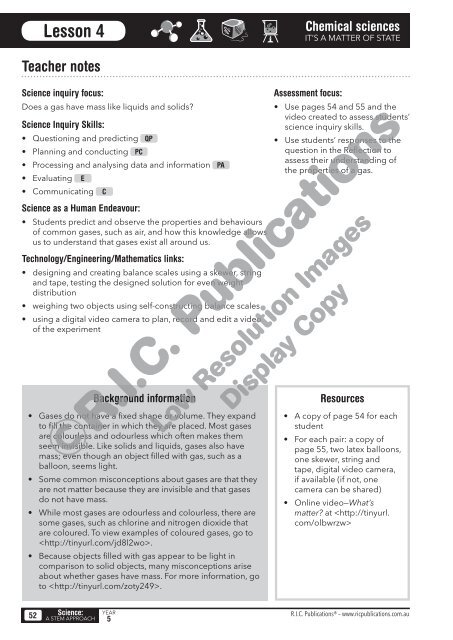20389_Science_with_STEM_Year_5_Chemical_Sciences_Its_a_matter_of_state
You also want an ePaper? Increase the reach of your titles
YUMPU automatically turns print PDFs into web optimized ePapers that Google loves.
Lesson 4<br />
<strong>Chemical</strong> sciences<br />
IT’S A MATTER OF STATE<br />
Teacher notes<br />
<strong>Science</strong> inquiry focus:<br />
Does a gas have mass like liquids and solids?<br />
<strong>Science</strong> Inquiry Skills:<br />
• Questioning and predicting QP<br />
• Planning and conducting PC<br />
• Processing and analysing data and information PA<br />
• Evaluating<br />
E<br />
• Communicating<br />
<strong>Science</strong> as a Human Endeavour:<br />
C<br />
• Students predict and observe the properties and behaviours<br />
<strong>of</strong> common gases, such as air, and how this knowledge allows<br />
us to understand that gases exist all around us.<br />
Technology/Engineering/Mathematics links:<br />
• designing and creating balance scales using a skewer, string<br />
and tape, testing the designed solution for even weight<br />
distribution<br />
• weighing two objects using self-constructing balance scales<br />
• using a digital video camera to plan, record and edit a video<br />
<strong>of</strong> the experiment<br />
Background information<br />
• Gases do not have a fixed shape or volume. They expand<br />
to fill the container in which they are placed. Most gases<br />
are colourless and odourless which <strong>of</strong>ten makes them<br />
seem invisible. Like solids and liquids, gases also have<br />
mass; even though an object filled <strong>with</strong> gas, such as a<br />
balloon, seems light.<br />
• Some common misconceptions about gases are that they<br />
are not <strong>matter</strong> because they are invisible and that gases<br />
do not have mass.<br />
• While most gases are odourless and colourless, there are<br />
some gases, such as chlorine and nitrogen dioxide that<br />
are coloured. To view examples <strong>of</strong> coloured gases, go to<br />
.<br />
• Because objects filled <strong>with</strong> gas appear to be light in<br />
comparison to solid objects, many misconceptions arise<br />
about whether gases have mass. For more information, go<br />
to .<br />
Assessment focus:<br />
• Use pages 54 and 55 and the<br />
video created to assess students’<br />
science inquiry skills.<br />
• Use students’ responses to the<br />
question in the Reflection to<br />
assess their understanding <strong>of</strong><br />
the properties <strong>of</strong> a gas.<br />
Resources<br />
• A copy <strong>of</strong> page 54 for each<br />
student<br />
• For each pair: a copy <strong>of</strong><br />
page 55, two latex balloons,<br />
one skewer, string and<br />
tape, digital video camera,<br />
if available (if not, one<br />
camera can be shared)<br />
• Online video—What’s<br />
<strong>matter</strong>? at <br />
©R.I.C. Publications<br />
Low Resolution Images<br />
Display Copy<br />
52 <strong>Science</strong>:<br />
A <strong>STEM</strong> APPROACH<br />
YEAR<br />
5<br />
R.I.C. Publications® – www.ricpublications.com.au


















